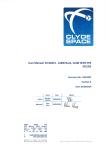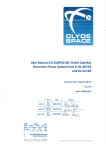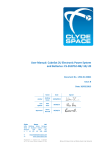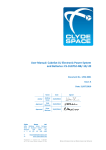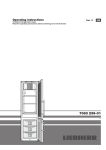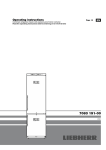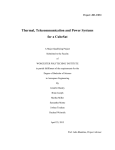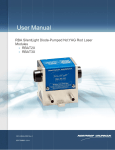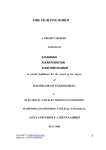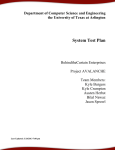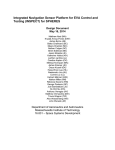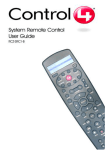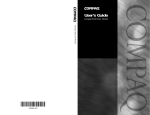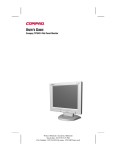Download User Manual - Clyde Space
Transcript
USM-0002 User Manual: FleXible Electronic Power System: CS-XUEPS2-41/-42 Issue: D Date: 26/02/2015 Page: 2 of 44 5B, Skypark 5, 45 Finnieston Street, Glasgow, G3 8JU Document Control Issue Date Section Description of Change Reason for Change A 22/07/10 All First Draft N/A B 30/07/2010 Revision Control Rev B onwards only 11.4 ADC conversion Equations Updated Telemetry equation changes Improvement of telemetry circuit accuracy C 19/01/2015 11.2 and 11.3 Section 11.2 and 11.3 minor updates Readability D 26/02/2015 Several Updates throughout to being in line with current build standard Updated hardware build standard Part Number Revisions covered Notes Revision Control Product Cubesat FleXible Power System Electronic CS-XUEPS2-42 B 4 Large BCRs, 2 Small BCRs Cubesat FleXible Power System Electronic CS-XUEPS2-41 E 4 Large BCRs, 1 Small BCR Acronyms and Abbreviations BCR Battery Charge Regulator PCM Power Conditioning Module PDM Power Distribution Module MPPT Maximum Power Point Tracker USB Universal Serial Bus ESD Electro Static Discharge TLM Telemetry EPS Electrical Power System EoC End of Charge AMUX Analogue Multiplexer ADC Analogue to Digital Converter AIT Assembly, Integration and Testing 1U 1 Unit (Cubesat standard size) 3U 3 Unit (Cubesat standard size) FleXU/XU FleXible Unit (suitable for various satellite configurations) rh Relative Humidity Wh Watt Hour Ah Ampere Hour DoD Depth of Discharge Kbits-1 Kilobits per second Voc Open Circuit Voltage Isc Short Circuit Current 2s1p Battery configuration – 2 cells in series, 1 battery in parallel (single string) 2s2p Battery configuration – 2 cells in series, 2 batteries in parallel 2s3p Battery configuration – 2 cells in series, 3 batteries in parallel SOLUTIONS FOR A NEW AGE IN SPACE PROPRIETARY & CONFIDENTIAL INFORMATION www.clyde-space.com © Clyde Space Limited 2015 USM-0002 Issue: D User Manual: FleXible Electronic Power System: CS-XUEPS2-41/-42 5B, Skypark 5, 45 Finnieston Street, Glasgow, G3 8JU Date: 26/02/2015 Page: 3 of 44 No. Document Name Doc Ref. RD-1 Battery board User Manual TBC RD-2 CubeSat Design Specification CubeSat Design Specification Rev. 12 RD-3 NASA General Environmental Verification Standard GSFC-STD-7000 April 2005 RD-4 CubeSat Kit Manual UM-3 RD-5 Solar Panel User Document Power System Design and Performance on the World’s Most Advanced In-Orbit Nanosatellite TBC Related Documents RD-6 # Warning As named Risk Ensure headers H1 and H2 are correctly aligned before mating boards If misaligned, battery positive can short to ground, causing failure of the battery and EPS Ensure switching configuration is implemented correctly before applying power to EPS If power is applied with incorrect switch configuration, the output of the BCR can be blown, causing failure of the EPS and subsequent damage to the battery Observe ESD precautions at all times The battery is a static sensitive system. Failure to observe ESD precautions can result in failure of the battery Ensure not to exceed the maximum stated limits Exceeding any of the stated maximum limits can result in failure of the battery Ensure batteries are fully isolated during storage If not fully isolated (by switch configuration or separation) the battery may over-discharge, resulting in failure of the battery No connection should be made to H2.35-36 These pins are used to connect the battery to the EPS. Any connections to the unregulated battery bus should be made to pins H2.43-44 H1 and H2 pins should not be shorted at any time These headers have exposed live pins which should not be shorted at any time. Particular care should be taken regarding the surfaces these are placed on. 8 Battery should only be operated when integrated with an EPS The EPS includes a number of protection circuits for the battery. Operation without these protections may lead to damage of the batteries 9 Do not discharge batteries below 6V If the battery is discharged to a voltage below 6V the cells have been compromised and will no longer hold capacity If batteries are over-discharged DO NOT attempt to recharge If the battery is over discharged (below 6V) it should not be recharged as this may lead to cell rupture. 10 10 SOLUTIONS FOR A NEW AGE IN SPACE PROPRIETARY & CONFIDENTIAL INFORMATION www.clyde-space.com © Clyde Space Limited 2015 USM-0002 Issue: D 1. User Manual: FleXible Electronic Power System: CS-XUEPS2-41/-42 Date: 26/02/2015 Page: 4 of 44 5B, Skypark 5, 45 Finnieston Street, Glasgow, G3 8JU Introduction .......................................................................................................................... 6 1.1 Additional Information Available Online ............................................................................................6 1.2 Continuous Improvement ...................................................................................................................6 1.3 Document Revisions ...........................................................................................................................6 2. Overview ............................................................................................................................... 7 3. Maximum Ratings(1) .............................................................................................................. 8 4. Electrical Characteristics ....................................................................................................... 9 5. Handling and storage .......................................................................................................... 10 5.1 Electro Static Discharge (ESD) Protection .........................................................................................10 5.2 General Handling ..............................................................................................................................10 5.3 Shipping and Storage ........................................................................................................................10 6. Materials and Processes ..................................................................................................... 11 6.1 Materials Used ..................................................................................................................................11 6.2 Processes and Procedures ................................................................................................................11 7. System Description ............................................................................................................. 12 7.1 System Overview ..............................................................................................................................13 7.2 Autonomy and Redundancy .............................................................................................................14 7.3 Quiescent Power Consumption ........................................................................................................14 7.4 Mass and Mechanical Configuration ................................................................................................14 8. Interfacing........................................................................................................................... 15 8.1 Connector Layout .............................................................................................................................15 8.2 Solar Array Connection .....................................................................................................................16 8.3 Solar Array Harness ..........................................................................................................................19 8.4 Temperature sensing interface.........................................................................................................19 8.5 Non-Clyde Space Solar Arrays ...........................................................................................................19 8.6 CubeSat Kit Compatible Headers ......................................................................................................20 8.7 Cubesat Kit Header Pin Out ..............................................................................................................21 8.8 Switch Options ..................................................................................................................................23 8.9 Battery connection ...........................................................................................................................25 8.10 Buses.................................................................................................................................................25 9. Technical description .......................................................................................................... 26 9.1 Charge Method .................................................................................................................................26 9.2 BCR Power Stage Overview ..............................................................................................................27 9.3 MPPT ................................................................................................................................................27 9.4 5V and 3.3V PCM ..............................................................................................................................28 10. General protection ............................................................................................................. 29 10.1 Over-Current Bus Protection ............................................................................................................29 10.2 Battery Under-voltage Protection ....................................................................................................30 11. 11.1 Telemetry and Telecommand ............................................................................................. 31 I2C Node ............................................................................................................................................31 SOLUTIONS FOR A NEW AGE IN SPACE PROPRIETARY & CONFIDENTIAL INFORMATION www.clyde-space.com © Clyde Space Limited 2015 USM-0002 Issue: D User Manual: FleXible Electronic Power System: CS-XUEPS2-41/-42 Date: 26/02/2015 Page: 5 of 44 5B, Skypark 5, 45 Finnieston Street, Glasgow, G3 8JU 11.2 Command Summary .........................................................................................................................33 11.3 ADC Channels and Conversion Equations .........................................................................................35 12. Test ..................................................................................................................................... 37 12.1 Power up/Down Procedure ..............................................................................................................37 12.2 Solar Array Input ...............................................................................................................................38 12.3 Battery Setup ....................................................................................................................................39 12.4 Configuration and Testing ................................................................................................................39 13. Developer AIT ..................................................................................................................... 42 14. Compatible Systems ........................................................................................................... 44 SOLUTIONS FOR A NEW AGE IN SPACE PROPRIETARY & CONFIDENTIAL INFORMATION www.clyde-space.com © Clyde Space Limited 2015 USM-0002 User Manual: FleXible Electronic Power System: CS-XUEPS2-41/-42 Issue: D Date: 26/02/2015 5B, Skypark 5, 45 Finnieston Street, Glasgow, G3 8JU Page: 6 of 44 1. INTRODUCTION This document provides information on the features, operation, handling and storage of the Clyde Space FleXU EPS. The FleXU EPS has been designed to be flexible to your satellite’s power requirements, providing four ‘large’ BCRs (for 4-8 cell solar panel pairs) and either one, or two ‘small’ BCRs (for 2 cell solar panel pairs). The FleXU EPS will integrate with a suitable battery and solar arrays to form a complete power system for use on a CubeSat or Nanosat. EPS BCR1 Over Current Protection 12W Ideal Diode BCR2 BCR_OUT PCM_IN 12W 3.3V REG Switch Configuration As Defined By User 12W BCR3 BCR4 USB +5V 5V REG 2 i c node 3W 12W TELEMETRY BCR5 BCR6* BATT_POS 3W 2 i c node TELEMETRY CLYDE SPACE 3U BATTERY * BCR6 only on CS-XUEPS2-42 and CS-XU-EPS2-42A Figure 1-1 System Diagram 1.1 Additional Information Available Online Additional information on CubeSats and Clyde Space Systems can be found at www.clydespace.com. You will need to login to our website to access certain documents. 1.2 Continuous Improvement At Clyde Space we are continuously improving our processes and products. We aim to provide full visibility of the changes and updates that we make, and information of these changes can be found by logging in to our website: http://www.clyde-space.com. 1.3 Document Revisions In addition to hardware and software updates, we also make regular updates to our documentation and online information. Notes of updates to documents can also be found at www.clyde-space.com. SOLUTIONS FOR A NEW AGE IN SPACE PROPRIETARY & CONFIDENTIAL INFORMATION www.clyde-space.com © Clyde Space Limited 2015 USM-0002 Issue: D User Manual: FleXible Electronic Power System: CS-XUEPS2-41/-42 Date: 26/02/2015 Page: 7 of 44 5B, Skypark 5, 45 Finnieston Street, Glasgow, G3 8JU 2. OVERVIEW This is the second generation of Clyde Space CubeSat Electronic Power System, developed by our team of highly experienced Spacecraft Power Systems and Electronics Engineers. Since introducing the first generation in 2006, Clyde Space has shipped over 120 EPS and Batteries to a variety of customers in Europe, Asia and North America. The second generation EPS builds on the heritage gained with the first generation, whilst increasing power delivery capability by approximately 50%. Furthermore, we have implemented an ideal diode mechanism, which ensures that there will be zero draw on the battery in launch configuration. Clyde Space is the World leading supplier of power system components for CubeSats. We have been designing, manufacturing, testing and supplying batteries, power system electronics and solar panels for space programmes since 2006. Our customers range from universities running student led missions, to major space companies and government organisations. SOLUTIONS FOR A NEW AGE IN SPACE PROPRIETARY & CONFIDENTIAL INFORMATION www.clyde-space.com © Clyde Space Limited 2015 USM-0002 User Manual: FleXible Electronic Power System: CS-XUEPS2-41/-42 Issue: D Date: 26/02/2015 5B, Skypark 5, 45 Finnieston Street, Glasgow, G3 8JU Page: 8 of 44 3. MAXIMUM RATINGS(1) OVER OPERATING TEMPERATURE RANGE (UNLESS OTHERWISE STATED) 4 BCR Value Unit SA1 (pin 1 or pin 4) BCR1 (12W) 25 V SA2 (pin 1 or pin 4) BCR2 (12W) 25 V SA3 (pin 1 or pin 4) BCR3 (12W) 25 V SA4 (pin 1 or pin 4) BCR4 (12W) 25 V SA5 (pin 1 or pin 4) BCR5 (3W) 10 V SA6 (pin 1 or pin 4)(3) BCR6 (3W) 10 V Battery 8.3 V 5V Bus 5.05 V 3.3V Bus 3.33 V Notes Value Unit BCR1-4 @16V 750 mA BCR5-6(3) @6V 750 mA Battery Bus @8.26V 6 A 5V Bus @5V 4 A 3.3V Bus @3.3V 4 A Operating Temperature -40 to +85 °C Storage Temperature -50 to +100 °C Vacuum 10-5 torr Radiation Tolerance (TBC) kRad Shock (TBC) Vibration To [RD-3] Input Voltage(2) Input Current Output Current Table 3-1 Max Ratings of the FleXU EPS2 (1) Stresses beyond those listed under maximum ratings may cause permanent damage to the EPS. These are the stress ratings only. Operation of the EPS at conditions beyond those indicated is not recommended. Exposure to absolute maximum ratings for extended periods may affect EPS reliability (2) De-rating of power critical components is in accordance with ECSS guidelines. (3) BCR 6 only available on CS-XUEPS2-42 SOLUTIONS FOR A NEW AGE IN SPACE PROPRIETARY & CONFIDENTIAL INFORMATION www.clyde-space.com © Clyde Space Limited 2015 USM-0002 User Manual: FleXible Electronic Power System: CS-XUEPS2-41/-42 Issue: D Date: 26/02/2015 Page: 9 of 44 5B, Skypark 5, 45 Finnieston Street, Glasgow, G3 8JU 4. ELECTRICAL CHARACTERISTICS Description Conditions Min Typical Max Unit 7.4 -- 25 V Output Voltage 6.2 -- 8.26 V Output Current 0 -- 1.2 A 245 250 255 KHz 85% 90% 92% 3.5 -- 8(1) V Output Voltage 6.2 -- 8.26 V Output Current 0 -- 0.5 A 160 170 180 KHz 77% 79% 80% Output Voltage 6.2 -- 8.26 V Output Current -- 4 4.2 A Operating Frequency -- -- -- 98.5% 99% 99.5% 12W BCR (1-4) Input Voltage Switching Frequency Efficiency @16.5V input, Full Load 3W BCR (5-6) Input Voltage Operating Frequency Efficiency @6V input, Full Load Unregulated Battery Bus Efficiency @8.26V input, Full Load 5V Bus Output Voltage 4.95 5 5.05 V Output Current -- 4 4.2 A 470 480 490 kHz 95% 96% 98% 3.276 3.3 3.333 V Output Current -- 4 4.2 A Operating Frequency 470 480 490 kHz 94% 95% 97% Protocol -- I2C -- Transmission speed -- 100 400 Operating Frequency Efficiency @5V input, Full Load 3.3V Bus Output Voltage Efficiency @3.3V input, Full Load Communications Bus voltage 3.26V 3.3V 3.33V Node address -- 0x2B -- Address scheme -- 7bit -- Node operating frequency -- 8MHz -- KBps Hex Quiescent Operation Power Draw Flight Configuration Switches of -- -- <0.1 L W H Height from top of PCB to bottom of next PCB in stack 95 90 15.24 mm CS-XUEPS2-41 130 133 136 g CS-XUEPS2-42 134 137 140 G Physical Dimensions Weight W Table 4-1 Performance Characteristics of the FleXU EPS2 (1) BCR6 can tolerate inputs of up to 9.18V on CS-XUEPS2-42A variant SOLUTIONS FOR A NEW AGE IN SPACE PROPRIETARY & CONFIDENTIAL INFORMATION www.clyde-space.com © Clyde Space Limited 2015 USM-0002 User Manual: FleXible Electronic Power System: CS-XUEPS2-41/-42 Issue: D Date: 26/02/2015 Page: 10 of 44 5B, Skypark 5, 45 Finnieston Street, Glasgow, G3 8JU 5. HANDLING AND STORAGE The EPS requires specific guidelines to be observed for handling, transportation and storage. These are stated below. Failure to follow these guidelines may result in damage to the units or degradation in performance. 5.1 Electro Static Discharge (ESD) Protection 3 The EPS incorporates static sensitive devices and care should be taken during handling. Do not touch the EPS without proper electrostatic protection in place. All work carried out on the system should be done in a static dissipative environment. 5.2 General Handling The EPS is designed to be robust and able to withstand flight conditions. However, care must be taken when handling the device. Do not drop the device as this can damage the EPS. There are live connections between the battery systems and the EPS on the CubeSat Kit headers. All metal objects (including probes) should be kept clear of these headers. Gloves should be worn when handling all flight hardware. Flight hardware should only be removed from packaging in a class 100000 (or better) clean room environment. 5.3 Shipping and Storage The devices are shipped in anti-static, vacuum-sealed packaging, enclosed in a hard protective case. This case should be used for storage. All hardware should be stored in anti-static containers at temperatures between 20°C and 40°C and in a humiditycontrolled environment of 40-60%rh. The shelf-life of this product is estimated at 5 years when stored appropriately. SOLUTIONS FOR A NEW AGE IN SPACE PROPRIETARY & CONFIDENTIAL INFORMATION www.clyde-space.com © Clyde Space Limited 2015 USM-0002 User Manual: FleXible Electronic Power System: CS-XUEPS2-41/-42 Issue: D Date: 26/02/2015 5B, Skypark 5, 45 Finnieston Street, Glasgow, G3 8JU Page: 11 of 44 6. MATERIALS AND PROCESSES 6.1 Materials Used Material Manufacturer %TML %CVCM %WVR Application 1. Araldite 2014 Epoxy Huntsman 0.97 0.05 0.33 Adhesive fixing 2. 1B31 Acrylic Humiseal 3.89 0.11 0.09 Conformal Coating 3. DC 6-1104 Dow Corning 0.17 0.02 0.06 Adhesive fixing on modifications 4. Stycast 4952 Emerson & Cuming 0.42 0.17 0.01 Thermally Conductive RTV 5. PCB material FR4 0.62 0 0.1 Note: worst case on NASA outgassing list 6. Solder Resist CARAPACE EMP110 or XV501T-4 0.95 or 0.995 0.02 Or 0.001 0.31 - 7. Solder Sn62 or Sn63 (Tin/Lead) - - - - 8. Flux Alpha Rosin Flux, RF800, ROL 0 - - - Note: ESA Recommended Table 6-1 Materials List Part Used Manufacturer Contact Insulator Type Use DF13-6P-1.25DSA(50) Hirose Gold Plated Polyamide PTH Solar Array Connectors ESQ-126-39-G-D Samtec Gold Plated Black Glass Filled Polyester PTH CubeSat Kit Compatible Headers DF13-6S-1.25C Hirose N/A Polyamide Crimp Housing Harness for Solar Arrays (sold separately) DF13-2630SCFA(04) Hirose Gold Plated N/A Crimp Harness for Solar Arrays (sold separately) Table 6-2 Connector Headers 6.2 Processes and Procedures All assembly is carried out and inspected to ESA Workmanship Standards; ECSS-Q-ST-7008C and ECSS-Q-ST-70-38C. SOLUTIONS FOR A NEW AGE IN SPACE PROPRIETARY & CONFIDENTIAL INFORMATION www.clyde-space.com © Clyde Space Limited 2015 USM-0002 Issue: D User Manual: FleXible Electronic Power System: CS-XUEPS2-41/-42 Date: 26/02/2015 Page: 12 of 44 5B, Skypark 5, 45 Finnieston Street, Glasgow, G3 8JU 7. SYSTEM DESCRIPTION The Clyde Space FleXU EPS is optimised for Low Earth Orbit (LEO) missions with a maximum altitude of 850km. The EPS is designed for integration with spacecraft that have multiple solar panels, which may be configured in a number of different ways, with a maximum of four pairs of 4-8 cell panels and two pairs of 2 cell panels (one 2 cell and one 3 cell for the CS-XUEPS2-42A variant of the EPS). Pairs should be arranged so that at any given time the panel pair cannot output any greater than 12W for the large panels and 3W for the small panels (4.5W on SA6 for the CS-XUEPS2-42A variant of the EPS). The EPS can accommodate various solar panel configurations, and has been designed to be versatile; please consult our support team if you have specific requirements for connecting the EPS to your spacecraft. The Clyde Space EPS connects to the solar panels via 5-6 independent Battery Charge Regulators (BCRs). Each BCR can be connected to two solar arrays in parallel, provided the connected panels cannot output a power greater than 12W for BCRs 1-4 and 3W for BCRs 5 and 6 (4.5W on SA6 for the CS-XUEPS2-42A variant of the EPS). There are a number of possible configurations that can be used, depending on the deployment configuration. Please contact Clyde Space to discuss possible configurations. Each of the BCRs has an inbuilt Maximum Power Point Tracker (MPPT). This MPPT will track the dominant panel of the connected pair (the directly illuminated panel). The output of all BCRs are then connected together and, via the switch network, (described in Section 7.2), supply charge to the battery, Power Conditioning Modules (PCMs) and Power Distribution Modules (PDMs) via the switch network. The PCM/PDM network has an unregulated Battery Voltage Bus, a regulated 5V supply and a regulated 3.3V supply available on the satellite bus. The EPS also has multiple inbuilt protection methods to ensure safe operation during the mission and a full range of EPS telemetry via the I2C network. These are discussed in detail in Sections 10 and 11 respectively. Figure 7-1 Some Possible Array Configuration SOLUTIONS FOR A NEW AGE IN SPACE PROPRIETARY & CONFIDENTIAL INFORMATION www.clyde-space.com © Clyde Space Limited 2015 SOLUTIONS FOR A NEW AGE IN SPACE PROPRIETARY & CONFIDENTIAL INFORMATION -ARRAY 1 2 3 4 TLM I TLM TLM I TLM TLM SENSING I V V TLM I BCR/ MPPT SENSING BCR/ MPPT BCR/ MPPT BCR/ MPPT AMUX PCM / PDM network END OF CHARGE H2.29,31-32 GND T L M BUCK CTRL TLM conditioning 3.3V PCM 5V PCM BUCK CTRL S HDN SHDN CTR L CTRL CTRL I2C Node TLM O/C CIRCUIT TLM O/C CI RCUIT I2C BUFFER H2.27-28 +3.3V BUS H2.25-26 +5V BUS 3W SEPIC BCR 3W SEPI C BCR BCR6 (Only on CS-XUEPS2-42) BCR5 8W BUCK BCR 8W BUCK BCR 8W BUCK BCR 8W BUCK BCR BCR/ MPPT BCR/BCR4 MPPT UNDER VOLTAGE CTRL -ARRAY TLM 6 1 2 3 4 TLM 5 TLM TLM TLM TLM TLM Page: 13 of 44 5 -ARRAY 6 +ARRAY +ARRAY TLM V TLM V TLM V TLM BCR3 Vbat t Current sensing H2.45-46 BATTERY BUS 2 3 6 -ARRAY 4 5 TLM 1 6 4 SENSING TLM I I 5 TLM 2 3 6 -ARRAY 4 TLM I I 5 TLM 1 4 SENSING TLM I I 5 TLM BCR2 CTRL Date: 26/02/2015 -ARRAY 6 +ARRAY 1 2 3 V H2.41-44 BCR_OUT SENSI NG TLM I I BCR1 H2.35-36 PCM_IN +ARRAY 1 2 3 SENSING Issue: D +ARRAY +ARRAY 7.1 IDEAL DIODE USM-0002 User Manual: FleXible Electronic Power System: CS-XUEPS2-41/-42 5B, Skypark 5, 45 Finnieston Street, Glasgow, G3 8JU System Overview H1. 43 I2C CLOCK H1.41 I2C DATA H1.32 5v USB Figure 7-2 Function Diagram www.clyde-space.com © Clyde Space Limited 2015 USM-0002 Issue: D User Manual: FleXible Electronic Power System: CS-XUEPS2-41/-42 Date: 26/02/2015 Page: 14 of 44 5B, Skypark 5, 45 Finnieston Street, Glasgow, G3 8JU 7.2 Autonomy and Redundancy All BCR power stages feature full system autonomy, operating solely from the solar array input and not requiring any power from the battery systems. This feature offers inbuilt redundancy since failure of one BCR does not affect remaining BCRs. Failure of the all strings of the battery (any of the CS-SBAT2-xx range) will not damage the BCRs but, due to the MPPT, will result in an intermittent interruption on all power buses (approximately every 2.5 seconds). Failure of one battery on the CS-SBAT-20 or two batteries on the CSSBAT2-30 will not damage the BCRs and the system can continue to operate with a reduced capacity of 10Wh. The rest of the power system is a robustly designed single string. 7.3 Quiescent Power Consumption All power system efficiencies detailed (for BCRs and PCMs) takes into consideration the associated low level control electronics. As such, these numbers are not included in the quiescent power consumption figures. The I2C node is the only circuitry not covered in the efficiency figures, and has a quiescent power consumption of ≈0.1W, which is the figure for the complete EPS. 7.4 Mass and Mechanical Configuration The mass of the system is approximately 133g and is contained on a PC/104 size mother card and mounted daughter card, compatible with the Cubesat Kit bus. Other versions of the EPS are available without the Cubesat Kit bus header. *SA6 only available on CS-XU-EPS2-42 and CS-XU-EPS2-42A Figure 7-3 Board dimensions (mm) SOLUTIONS FOR A NEW AGE IN SPACE PROPRIETARY & CONFIDENTIAL INFORMATION www.clyde-space.com © Clyde Space Limited 2015 USM-0002 User Manual: FleXible Electronic Power System: CS-XUEPS2-41/-42 Issue: D Date: 26/02/2015 5B, Skypark 5, 45 Finnieston Street, Glasgow, G3 8JU Page: 15 of 44 8. INTERFACING The interfacing of the EPS is outlined in Figure 8-1, including the solar array inputs, connection to the switch configuration, output of the power buses and communication to the I2C node. In the following section it is assumed that the EPS will be integrated with a Clyde Space Battery (CS-SBAT2-xx and/or CS-RBAT2-10). EPS BCR1 12W Ideal Diode BCR_OUT PCM_IN BCR2 12W Switch Configuration As Defined By User 12W BCR3 BCR4 Over Current Protection 5V REG 3.3V REG 2 i c node 3W 12W USB +5V TELEMETRY BCR5 BCR6 BATT_POS 3W 2 i c node TELEMETRY CLYDE SPACE 3U BATTERY Figure 8-1 Clyde Space EPS and Battery Simplified Connection Diagram 8.1 Connector Layout 1 The connector positions are shown in Figure 7-3, and described in Table 8.1. Connector Function SA1 Solar Array connector for 12W +/- arrays SA2 Solar Array connector for 12W +/- arrays SA3 Solar Array connector for 12W +/- arrays SA4 Solar Array connector for 12W +/- arrays SA5 Solar Array connector for 3W +/- arrays SA6* Solar Array connector for 3W +/- arrays (4.5W on CS-XUEPS2-42A variant EPS) H1 Cubesat Kit bus compatible Header 1 H2 Cubesat Kit bus compatible Header 2 *CS-XUEPS2-42 and CS-XUEPS2-42A only SOLUTIONS FOR A NEW AGE IN SPACE PROPRIETARY & CONFIDENTIAL INFORMATION www.clyde-space.com © Clyde Space Limited 2015 USM-0002 Issue: D User Manual: FleXible Electronic Power System: CS-XUEPS2-41/-42 Date: 26/02/2015 Page: 16 of 44 5B, Skypark 5, 45 Finnieston Street, Glasgow, G3 8JU Table 8-1 Connector functions 8.2 Solar Array Connection The EPS has 5-6 connectors for the attachment of solar arrays. This interface accommodates inputs from the arrays with temperature telemetry for each. Max Cells + Max Cells + CLYDE SPACE EPS V TLM Min Cells SA1.1 Min Cells BCR_OUT BCR1 SA1.2 SA1.3 I TLM Temp TLM V TLM SA1.4 SA1.5 SA1.6 I TLM Temp TLM - +Solar Array - -Solar Array Figure 8-2 Solar Array Configuration HIROSE DP12-6P-1.25 DSA connector sockets are used on the EPS. These are labelled SA1SA6. SA1-SA4 are routed to BCR1-BCR4 respectively. These BCRs are capable of interfacing to 12W panels and should be harnessed to arrays with between 4-8 triple junction solar cells in series. SA5-SA6 route to BCR5-BCR6 respectively, each of which are 3W (BCR6 is 4.5W on CSXUEPS2-42A variant) channels that should be harnessed to the small arrays. The array lengths should be the same on joined panels, with 2 cells each (3 cells possible on SA6 with CS-XUEPS2-42A variant). Figure 8-3 Solar Array Pin Numbering SOLUTIONS FOR A NEW AGE IN SPACE PROPRIETARY & CONFIDENTIAL INFORMATION www.clyde-space.com © Clyde Space Limited 2015 USM-0002 User Manual: FleXible Electronic Power System: CS-XUEPS2-41/-42 Issue: D Pin Date: 26/02/2015 Page: 17 of 44 Name 5B, Skypark 5, 45 Finnieston Street, Glasgow, G3 8JU Use Notes 1 + ARRAY1 (12W) + Power Line Power 2 GND Ground Line Power RTN and GND connection for Temp Sensor 3 +ARRAY1_TEMP_TELEM + Array1 Telemetry Telemetry 4 - ARRAY1 (12W) - Power Line Power 5 GND Ground Line Power RTN and GND connection for Temp Sensor 6 -ARRAY1_TEMP_TELEM - Array1 Telemetry Telemetry Pin Name Table 8-2 Pin out for Header SA1 Use Notes 1 + ARRAY2 (12W) + Power Line Power 2 GND Ground Line Power RTN and GND connection for Temp Sensor 3 +ARRAY2_TEMP_TELEM + ARRAY2 Telemetry Telemetry 4 - ARRAY2 (12W) - Power Line Power 5 GND Ground Line Power RTN and GND connection for Temp Sensor 6 -ARRAY2_TEMP_TELEM - ARRAY2 Telemetry Telemetry Table 8-3 Pin out for Header SA2 Pin Name Use Notes 1 + ARRAY3 (12W) + Power Line Power 2 GND Ground Line Power RTN and GND connection for Temp Sensor 3 +ARRAY3_TEMP_TELEM + ARRAY3 Telemetry Telemetry 4 - ARRAY3 (12W) - Power Line Power 5 GND Ground Line Power RTN and GND connection for Temp Sensor 6 -ARRAY3_TEMP_TELEM - ARRAY3 Telemetry Telemetry Table 8-4 Pin out for Header SA3 Pin Name Use Notes 1 + ARRAY4 (12W) + Power Line Power 2 GND Ground Line Power RTN and GND connection for Temp Sensor 3 +ARRAY4_TEMP_TELEM + ARRAY4 Telemetry Telemetry 4 - ARRAY4 (12W) - Power Line Power 5 GND Ground Line Power RTN and GND connection for Temp Sensor 6 -ARRAY4_TEMP_TELEM - ARRAY4 Telemetry Telemetry Table 8-5 Pin out for Header SA4 SOLUTIONS FOR A NEW AGE IN SPACE PROPRIETARY & CONFIDENTIAL INFORMATION www.clyde-space.com © Clyde Space Limited 2015 USM-0002 User Manual: FleXible Electronic Power System: CS-XUEPS2-41/-42 Issue: D Pin Date: 26/02/2015 Name 5B, Skypark 5, 45 Finnieston Street, Glasgow, G3 8JU Page: 18 of 44 Use Notes 1 + ARRAY5 (3W) + Power Line Power 2 GND Ground Line Power RTN and GND connection for Temp Sensor 3 +ARRAY5_TEMP_TELEM + ARRAY5 Telemetry Telemetry 4 - ARRAY5 (3W) - Power Line Power 5 GND Ground Line Power RTN and GND connection for Temp Sensor 6 -ARRAY5_TEMP_TELEM - ARRAY5 Telemetry Telemetry Table 8-6 Pin out for Header SA5 Pin Name * Use Notes 1 + ARRAY6 (3W) + Power Line Power 2 GND Ground Line Power RTN and GND connection for Temp Sensor 3 +ARRAY6_TEMP_TELEM + ARRAY6 Telemetry Telemetry 4 - ARRAY6 (3W)* - Power Line Power 5 GND Ground Line Power RTN and GND connection for Temp Sensor 6 -ARRAY6_TEMP_TELEM - ARRAY6 Telemetry Telemetry *4.5W on CS-XUEPS2-42A variant Table 8-7 Pin out for Header SA6 (CS-XUEPS2-42 only) SOLUTIONS FOR A NEW AGE IN SPACE PROPRIETARY & CONFIDENTIAL INFORMATION www.clyde-space.com © Clyde Space Limited 2015 USM-0002 Issue: D User Manual: FleXible Electronic Power System: CS-XUEPS2-41/-42 Date: 26/02/2015 5B, Skypark 5, 45 Finnieston Street, Glasgow, G3 8JU Page: 19 of 44 8.3 Solar Array Harness Clyde Space supply harnesses (sold separately) to connect the solar panels to the EPS, comprising two Hirose DF13-6S-1.25C connected at each end of the cable; one end connects to the EPS, with two halves of the harness connecting to opposing solar panels. Clyde Space solar arrays use Hirose DF13-6P-1.25H as the interface connector to the harness. 8.4 Temperature sensing interface Temperature sensing telemetry is provided for each solar array connected to the EPS. A compatible temperature sensor (LM335M) is fitted as standard on Clyde Space solar arrays (for non-Clyde Space panels refer to section 8.5). The output from the LM335M sensor is then passed to the telemetry system via on board signal conditioning. Due to the nature of the signal conditioning, the system is only compatible with zener based temperature sensors i.e. LM335M or equivalent. Thermistor or thermocouple type sensors are incompatible with the conditioning circuit. Min Cells CLYDE SPACE EPS SAx.1 SAx.2 470pF 1.2kΩ +5V Bus 180kΩ 100kΩ SAx.3 100kΩ AMUX - + Micro Controller ADC 1.5V Ref Solar Array Figure 8-4 Temperature sensor block diagram 8.5 Non-Clyde Space Solar Arrays When connecting non-Clyde Space solar arrays care must be taken with the polarity, Pins 1,2 and 3 are for array(+)and pins 4, 5 and 6 relate to the opposite array (-). Cells used should be of triple junction type. If other cells are to be interfaced please contact Clyde Space. SOLUTIONS FOR A NEW AGE IN SPACE PROPRIETARY & CONFIDENTIAL INFORMATION www.clyde-space.com © Clyde Space Limited 2015 USM-0002 User Manual: FleXible Electronic Power System: CS-XUEPS2-41/-42 Issue: D Date: 26/02/2015 5B, Skypark 5, 45 Finnieston Street, Glasgow, G3 8JU Page: 20 of 44 8.6 CubeSat Kit Compatible Headers 1 Connections from the EPS to the bus of the satellite are made via the CubeSat Kit compatible headers H1 and H2, as shown in Figure 8-6. 6 7 H2 H1 5V BUS 5V BUS 3.3V BUS 3.3V BUS GND GND USB 5V R265 NF R264 NF BATT POS BATT POS PCM IN PCM IN DUMMY LOAD DUMMY LOAD N/C N/C I2C DATA R255 NF BCR OUT BCR OUT I2C CLK BAT BUS BAT BUS Figure 8-5 CubeSat Kit Header Schematic 3.3V BUS 5V BUS BATT GND POS USB CHARGING PCM IN BCR OUT BAT BUS DUMMY LOAD I2C DATA I2C CLK Figure 8-6 EPS Connector Pin Identification SOLUTIONS FOR A NEW AGE IN SPACE PROPRIETARY & CONFIDENTIAL INFORMATION www.clyde-space.com © Clyde Space Limited 2015 USM-0002 User Manual: FleXible Electronic Power System: CS-XUEPS2-41/-42 Issue: D Date: 26/02/2015 5B, Skypark 5, 45 Finnieston Street, Glasgow, G3 8JU Page: 21 of 44 8.7 Cubesat Kit Header Pin Out HEADER 1 Use Not Connected Not Connected Not Connected Not Connected Not Connected Not Connected Not Connected Not Connected Not Connected Not Connected Not Connected Not Connected Not Connected Not Connected Not Connected Not Connected Not Connected Not Connected Not Connected Not Connected Pin 1 2 3 4 5 6 7 8 9 10 11 12 13 14 15 16 17 18 19 20 Name NC NC NC NC NC NC NC NC NC NC NC NC NC NC NC NC NC NC NC NC 21 ALT I2C CLK Alt I2C clock connection 22 NC Not Connected 23 ALT I2C DATA Alt I2C data connection 24 25 26 NC NC NC 27 HEADER 2 Use Not Connected Not Connected Not Connected Not Connected Not Connected Not Connected Not Connected Not Connected Not Connected Not Connected Not Connected Not Connected Not Connected Not Connected Not Connected Not Connected Not Connected Not Connected Not Connected Not Connected Notes Not Connected Not Connected Not Connected Not Connected Not Connected Not Connected Not Connected Not Connected Not Connected Not Connected Not Connected Not Connected Not Connected Not Connected Not Connected Not Connected Not Connected Not Connected Not Connected Not Connected NC Not Connected Not Connected 22 NC Not Connected Not Connected 23 NC Not Connected Not Connected 24 25 26 NC +5V BUS +5V BUS +3.3V BUS +3.3V BUS Not Connected +5V Power bus +5V Power bus +3V3 Power bus +3V3 Power bus Ground connection Ground connection Not Connected Ground connection Not Connected Regulated 5V bus Regulated 5V bus Regulated 3V3 bus Regulated 3V3 bus System power return System power return Not Connected System power return Pull pin normally connected pin Pull pin normally connected pin Sep SW normally connected pin Sep SW normally connected pin Pull pin normally open pin Pull pin normally open pin Not Connected Not Connected Common point PP +SS pins Common point PP +SS pins Common point PP +SS pins Common point PP +SS pins Output to battery bus Output to battery bus Not Connected Not Connected Not Connected Pin 1 2 3 4 5 6 7 8 9 10 11 12 13 14 15 16 17 18 19 20 Name NC NC NC NC NC NC NC NC NC NC NC NC NC NC NC NC NC NC NC NC 21 Not Connected Not Connected Not Connected Notes Not Connected Not Connected Not Connected Not Connected Not Connected Not Connected Not Connected Not Connected Not Connected Not Connected Not Connected Not Connected Not Connected Not Connected Not Connected Not Connected Not Connected Not Connected Not Connected Not Connected 0ohm resistor R265 (must fit to operate) Not Connected 0ohm resistor R264 (must fit to operate) Not Connected Not Connected Not Connected NC Not Connected Not Connected 27 28 NC Not Connected Not Connected 28 29 NC Not Connected Not Connected 29 GND 30 NC Not Connected Not Connected 30 GND 31 NC Not Connected 31 NC 32 USB_5 USB 5+v Not Connected Use to charge battery via USB 32 GND BATT POS BATT POS 33 NC Not Connected Not Connected 33 34 NC Not Connected Not Connected 34 35 NC Not Connected Not Connected 35 PCM IN 36 NC Not Connected Not Connected 36 PCM IN Power line Power line Power line Power line 37 NC Not Connected Not Connected 37 38 NC Not Connected Not Connected 38 DL 39 40 NC NC Not Connected Not Connected 39 40 NC NC 41 I2C DATA I2C data Not Connected Not Connected Data for I2C communications Dummy Load Protection Dummy Load Protection Not Connected Not Connected 41 BCR OUT Power line 42 NC Not Connected Not Connected 42 BCR OUT Power line 43 BCR OUT Power line 44 BCR OUT Power line 43 I2C CLK I2C clock Clock for I2C communications 44 NC Not Connected Not Connected 45 NC Not Connected Not Connected 45 46 NC Not Connected Not Connected 46 47 48 49 NC NC NC Not Connected Not Connected Not Connected Not Connected Not Connected Not Connected 47 48 49 SOLUTIONS FOR A NEW AGE IN SPACE PROPRIETARY & CONFIDENTIAL INFORMATION DL Battery Bus Battery Bus NC NC NC Power line Power line Not Connected Not Connected Not Connected www.clyde-space.com © Clyde Space Limited 2015 USM-0002 User Manual: FleXible Electronic Power System: CS-XUEPS2-41/-42 Issue: D Pin 50 51 52 Name NC NC NC Date: 26/02/2015 HEADER 1 Use Not Connected Not Connected Not Connected 5B, Skypark 5, 45 Finnieston Street, Glasgow, G3 8JU Page: 22 of 44 Notes Not Connected Not Connected Not Connected Pin 50 51 52 Name NC NC NC HEADER 2 Use Notes Not Connected Not Connected Not Connected Not Connected Not Connected Not Connected Table 8-8 Pin Descriptions for Header H1 and H2 6 NODE HEADER CUBESAT KIT NAME NOTES +5V BUS 2.25-26 +5V 5V Regulated Bus Output +3.3V BUS 2.27-28 VCC_SYS 3.3V Regulated Bus Output BATT POS 2.33-34 SW0 Positive Terminal of Battery (not Battery Bus) DO NOT CONNECT PCM IN 2.35-36 SW1 (Switches ) Input to PCMs and PDMs DUMMY LOAD 2.37-38 SW2 (Switches ) N/C 2.39-40 SW3 (Switches N/C) Unused connection of launch switch closed state BCR OUT 2.41-44 SW4 Output of BCRs ( BCR OUT 2.41-44 SW5 Output of BCRs ( BATTERY BUS 2.45-46 VBATT+ Switches) Switches) Battery Unregulated Bus Output Table 8-9 Header pin name descriptions relating CubeSat Kit names to CS names SOLUTIONS FOR A NEW AGE IN SPACE PROPRIETARY & CONFIDENTIAL INFORMATION www.clyde-space.com © Clyde Space Limited 2015 USM-0002 User Manual: FleXible Electronic Power System: CS-XUEPS2-41/-42 Issue: D Date: 26/02/2015 5B, Skypark 5, 45 Finnieston Street, Glasgow, G3 8JU Page: 23 of 44 8.8 Switch Options The Clyde Space EPS has three connection points for switch attachments, as shown in Figure 8-7. There are a number of possible switch configurations for implementation. Each configuration must ensure the buses are isolated from the arrays and battery during launch. The batteries should also be isolated from the BCRs during launch in order to conform to CubeSat standard [RD-2]. CLYDE SPACE EPS BCR_OUT H2.41-44 User Defined Switch Configuration H2.39-40 N/C PCM_IN H2.35-36 DUMMY_LOAD H2.37-38 H2.33-34 BATT_POS CLYDE SPACE BATTERY Figure 8-7 Switch connection points Dummy Load The Dummy Load is available as an additional ground support protection system, providing a load for the BCRs when the pull pin is inserted using the normally open (NO) connection of the Pull Pin. By connecting this Dummy Load to the NO pin BCR damage can be circumvented. The wiring arrangement for the dummy load is indicated in Figure 8-8. The load protects the battery charge regulator from damage when the USB or array power is attached and the batteries are not connected. This system is not operational during flight and is only included as a ground support protection. The Clyde Space Dummy Load system has been a standard feature from revision D of the EPS onwards. If the Dummy Load is required for an earlier revision please contact Clyde Space for fitting instructions. Options 1 and 2 below are two suggested methods of switch configuration, but are by no means exhaustive. If you wish to discuss other possible configurations please contact Clyde Space. SOLUTIONS FOR A NEW AGE IN SPACE PROPRIETARY & CONFIDENTIAL INFORMATION www.clyde-space.com © Clyde Space Limited 2015 USM-0002 Issue: D User Manual: FleXible Electronic Power System: CS-XUEPS2-41/-42 Date: 26/02/2015 5B, Skypark 5, 45 Finnieston Street, Glasgow, G3 8JU Page: 24 of 44 Option 1 CLYDE SPACE EPS H2.39-40 N/C PCM_IN H2.35-36 SEPARATION SWITCH BCR_OUT H2.41-44 DUMMY_LOAD H2.37-38 PULL PIN H2.33-34 BATT_POS CLYDE SPACE BATTERY Figure 8-8 Switch Configuration Option 1 Option 1 accommodates the CubeSat Kit bus available switches offering two-stage isolation. The separation switch provides isolation of the power buses during the launch. The pull pin may be used for ground based isolation of the batteries, though it does not provide any isolation during launch. NOTE: The second generation Clyde Space EPS has zero-current draw when the pull pin is removed – i.e. there will be no current drawn from the battery while on the launch vehicle. When pull pin is inserted, the battery is isolated from the output of the BCRs. Under these conditions, if power is applied to the input of the arrays, or by connecting the USB, there is a possibility of damaging the system. In order to mitigate this risk a “Dummy Load” is fitted on the EPS. Option 2 CLYDE SPACE EPS SEPARATION SWITCH 1 BCR_OUT H2.41-44 H2.39-40 N/C PCM_IN H2.35-36 DUMMY_LOAD SEPARATION SWITCH 2 H2.37-38 H2.33-34 BATT_POS CLYDE SPACE BATTERY Figure 8-9 Switch Configuration Option 2 Option 2 is compatible with structures incorporating two separation switches, providing complete isolation in the launch configuration. The dummy load is not activated in this configuration. SOLUTIONS FOR A NEW AGE IN SPACE PROPRIETARY & CONFIDENTIAL INFORMATION www.clyde-space.com © Clyde Space Limited 2015 USM-0002 Issue: D User Manual: FleXible Electronic Power System: CS-XUEPS2-41/-42 Date: 26/02/2015 Page: 25 of 44 5B, Skypark 5, 45 Finnieston Street, Glasgow, G3 8JU Care should be taken to ensure that the switches used are rated to the appropriate current levels. Please contact Clyde Space for information on implementing alternative switch or dummy load configurations. 8.9 Battery connection 1 4 Connection of the battery systems on the FleXU EPS is via the Cubesat kit bus. Ensure that the pins are aligned, and located in the correct position, as any offset can cause the battery to be shorted to ground, leading to catastrophic failure of the battery and damage to the EPS. Failure to observe these precautions will result in the voiding of any warranty. When the battery is connected to the EPS, the battery will be fully isolated until implementing and connecting a switch configuration, as discussed in Section 8.8. Ensure that the battery is fully isolated during periods of extended storage. When a battery board is connected to the CubeSat Kit header, there are live, unprotected battery pins accessible (H2.33-34). These pins should not be routed to any connections other than the switches and Clyde Space EPS, otherwise all protections will be bypassed and significant battery damage can be sustained. 8.10 Buses All power buses are accessible via the CubeSat Kit headers and are listed and described in Table 8-8. These are the only power connections that should be used by the platform since they follow all battery and bus over-current protections. All I2C communications can are accessible via the CubeSat kit header. See Section 11. SOLUTIONS FOR A NEW AGE IN SPACE PROPRIETARY & CONFIDENTIAL INFORMATION www.clyde-space.com © Clyde Space Limited 2015 USM-0002 User Manual: FleXible Electronic Power System: CS-XUEPS2-41/-42 Issue: D Date: 26/02/2015 Page: 26 of 44 5B, Skypark 5, 45 Finnieston Street, Glasgow, G3 8JU 9. TECHNICAL DESCRIPTION This section gives a complete overview of the operational modes of the EPS. It is assumed that a complete Clyde Space system (EPS, Batteries and Solar panels) is in operation for the following sections. 9.1 Charge Method The BCR charging system has two modes of operation: Maximum Power Point Tracking (MPPT) mode and End of Charge (EoC) mode. These modes are governed by the state of charge of the battery. MPPT Mode If the battery voltage is below the preset EoC voltage the system is in MPPT mode. This is based on constant current charge method, operating at the maximum power point of the solar panel for maximum power transfer. EoC Mode Once the EoC voltage has been reached, the BCR changes to EoC mode, which is a constant voltage charging regime. The EoC voltage is held constant and a tapering current from the panels is supplied to top up the battery until at full capacity. In EoC mode the MPPT circuitry moves the solar array operation point away from the maximum power point of the array, drawing only the required power from the panels. The excess power is left on the arrays as heat, which is transferred to the structure via the array’s thermal dissipation methods incorporated in the panels. The operation of these two modes can be seen in Figure 9-1. end of charge voltage Figure 9-1 Tapered charging method SOLUTIONS FOR A NEW AGE IN SPACE PROPRIETARY & CONFIDENTIAL INFORMATION www.clyde-space.com © Clyde Space Limited 2015 USM-0002 User Manual: FleXible Electronic Power System: CS-XUEPS2-41/-42 Issue: D Date: 26/02/2015 Page: 27 of 44 5B, Skypark 5, 45 Finnieston Street, Glasgow, G3 8JU The application of constant current/constant voltage charge method on a spacecraft is described in more detail in [RD-6]. In this document there is on-orbit data showing the operation and how the current fluctuates with changing illumination conditions and orientation of the spacecraft with respect to the Sun. 9.2 BCR Power Stage Overview As discussed in Section 8, the EPS has six separate, independent BCRs, each designed to interface to two parallel solar arrays configured to have a combined output of no greater than 12W (e.g. a body mounted panel and deployed panel with cells facing the opposite direction). Four 12W BCRs interface to the main body and deployed panels, with 6-8 triple junction cells in series. The two small 3W BCRs can interface to strings of 2 triple junction cells in series, normally on the Z axis faces. Each design offers a highly reliable system that can deliver up to 90% of the power delivered from the solar array network at full load. 12W BCR power stage The 12W BCR is a BUCK converter, allowing the BCR to interface to strings of four to eight cells in series. This will deliver up to 90% output at full load. The design will operate with input voltages between 10V and 24V and a maximum output of 8.26V (7.4V nominal). 3W BCR Power Stage Design Each 3W BCR uses a high efficiency SEPIC converter, interfacing to solar arrays of two triple junction cells in series. This will deliver up to 80% output at full load. The BCR will operate with an input of between 3V and 6V and a maximum output of 8.26V (7.4V nominal). 4.5W BCR Power Stage Design (only present on BCR6 of CS-XUEPS2-42A variant) The 4.5W BCR uses a high efficiency SEPIC converter, interfacing to solar arrays of up to three triple junction cells in series. This will deliver up to 80% output at full load. The BCR will operate with an input of between 3V and 9.18V and a maximum output of 8.26V (7.4V nominal). 9.3 MPPT Each of the BCRs can have two solar arrays connected at any given time; only one array can be illuminated by sunlight, although the other may receive illumination by albedo reflection from earth. The dominant array is in sunlight and this will operate the MPPT for that BCR string. The MPPT monitors the power supplied from the solar array. This data is used to calculate the maximum power point of the array. The system tracks this point by periodically adjusting the BCRs to maintain the maximum power derived from the arrays. This technique ensures that the solar arrays can deliver much greater usable power, increasing the overall system performance. SOLUTIONS FOR A NEW AGE IN SPACE PROPRIETARY & CONFIDENTIAL INFORMATION www.clyde-space.com © Clyde Space Limited 2015 USM-0002 User Manual: FleXible Electronic Power System: CS-XUEPS2-41/-42 Issue: D Date: 26/02/2015 5B, Skypark 5, 45 Finnieston Street, Glasgow, G3 8JU Page: 28 of 44 Increasing Temperature Maximum Power Point I s/c Array Current I MPP Increasing Temperature V MPP Vo/c Array Voltage Figure 9-2 Solar Array Maximum Power Point The monitoring of the MPP is done approximately every 2.5 seconds. During this tracking, the input of the array will step to o/c voltage, as shown in Figure 9.3. Figure 9-3 Input waveform with Maximum Power Point Tracking 9.4 5V and 3.3V PCM The 5V and 3.3V regulators both use buck switching topology regulators as their main converter stage. The regulator incorporates intelligent feedback systems to ensure the voltage regulation is maintained to +/- 1% deviation. The efficiency of each unit at full load is approximately 96% for the 5V PCM and 95% for the 3.3V PCM. Full load on each of the regulators is a nominal output current of 4A. Each regulator operates at a frequency of 480 kHz. SOLUTIONS FOR A NEW AGE IN SPACE PROPRIETARY & CONFIDENTIAL INFORMATION www.clyde-space.com © Clyde Space Limited 2015 USM-0002 User Manual: FleXible Electronic Power System: CS-XUEPS2-41/-42 Issue: D Date: 26/02/2015 5B, Skypark 5, 45 Finnieston Street, Glasgow, G3 8JU Page: 29 of 44 10. GENERAL PROTECTION The EPS has a number of inbuilt protections and safety features designed to maintain safe operation of the EPS, battery and all subsystems supplied by the EPS buses. 10.1 Over-Current Bus Protection The EPS features bus protection systems to safeguard the battery, EPS and attached satellite sub-systems. This is achieved using current monitors and a shutdown network within the PDMs. Over-current shutdowns are present on all buses for sub system protection. These are solid state switches that monitor the current and shutdown at predetermined load levels, see Table 10-1. The bus protection will then monitor the fault periodically and reset when the fault clears. The fault detection and clear is illustrated in the waveform in Figure 101. SYSTEM SHUTDOWN OVER CURRENT EVENT TEST PERIOD EVENT CLEARS TEST PERIOD SYSTEM RESUME BUS VOLTAGE CURRENT NORMAL LEVEL NORMAL OPERATION NORMAL OPERATION Shutdown period Shutdown period Shutdown period Figure 10-1 Current protection system diagram Bus Period Approximate Duration (ms) Shutdown period 650 Battery Bus Test period 60 Shutdown period 585 5V Bus Test period 30 Shutdown period 525 Test period 30 3.3V Bus Table 10-1 Bus protection data SOLUTIONS FOR A NEW AGE IN SPACE PROPRIETARY & CONFIDENTIAL INFORMATION www.clyde-space.com © Clyde Space Limited 2015 USM-0002 Issue: D 10.2 User Manual: FleXible Electronic Power System: CS-XUEPS2-41/-42 Date: 26/02/2015 Page: 30 of 44 5B, Skypark 5, 45 Finnieston Street, Glasgow, G3 8JU Battery Under-voltage Protection In order to prevent the over-discharge of the battery the EPS has in-built under-voltage shutdown. This is controlled by a comparator circuit with hysteresis. In the event of the battery discharging to ~6.2V (slightly above the 6.1V that results in significant battery degradation) the EPS will shut down the supply buses. This will also result in the I2C node shutting down. When a power source is applied to the EPS (e.g. an illuminated solar panel) the battery will begin charging immediately. The buses, however, will not reactivate until the battery voltage has risen to ~7V. This allows the battery to charge to a level capable of sustaining the power lines once a load is applied. It is recommended that the battery state of charge is monitored and loading adjusted appropriately (turning off of non-critical systems) when the battery capacity is approaching the lower limit. This will prevent the hard shutdown provided by the EPS. Once the under-voltage protection is activated there is a monitoring circuit used to monitor the voltage of the battery. This will draw approximately 2mA for the duration of shutdown. As the EPS is designed for LEO orbit the maximum expected period in undervoltage is estimated to be ~40mins. When ground testing this should be taken into consideration, and the battery should be recharged within 40mins of reaching undervoltage, otherwise permanent damage may be sustained. SOLUTIONS FOR A NEW AGE IN SPACE PROPRIETARY & CONFIDENTIAL INFORMATION www.clyde-space.com © Clyde Space Limited 2015 USM-0002 Issue: D User Manual: FleXible Electronic Power System: CS-XUEPS2-41/-42 Date: 26/02/2015 Page: 31 of 44 5B, Skypark 5, 45 Finnieston Street, Glasgow, G3 8JU 11. TELEMETRY AND TELECOMMAND The telemetry system monitors certain stages of the power system and allows a small degree of control over the PDM stages. The telemetry system transfers data via an I2C bus. The telemetry system operates in slave mode and requires an I2C master to supply commands and the clock signal. Control systems within the EPS offer the user the ability to temporarily isolate the EPS buses from the on-board computer systems. ARRAY Sense voltage BCR1 Sense current ARRAY Sense voltage temperture BCR2 Sense current ARRAY Sense voltage temperture BCR3 Sense current ARRAY Sense voltage temperture BCR4 Sense current ARRAY Sense voltage temperture BCR5 Sense current ARRAY Sense voltage temperture BCR6 Sense current AMUX x2 Sensing Current VBAT PDM Sensing Current 5V PDM Sensing Current 3.3V PDM temperture I2C data bus 2 I C NODE Signal line Control line Figure 11-1 Telemetry functional diagram 11.1 I2C Node All communications to the Telemetry and Telecommand, TTC, node are made using an I²C interface which is configured as a slave and only responds to direct commands from a master I²C node - no unsolicited telemetry is transmitted. The 7-bit I2C address of the TTC Node is factory set at 0x2B and the I2C node will operate at up to 100kHz bus clock. Command Protocol Two message structures are available to the master; a write command and a read command. The write command is used to initiate an event and the read command returns the result. All commands start with the 7 bit slave address and are followed by two data bytes. When reading data responses both data bytes should be read together. A delay of at least 1.2ms should be inserted between sending a command and reading the telemetry response. This is required to allow the microcontroller to select the appropriate analogue channel, allow it to settle, and then sample the telemetry reading. In a write command the first data byte will determine the command to be initiated and the second data byte will hold a parameter associated with that command. For commands which have no specific requirement for a parameter input the second data byte should be set to 0x00. In a read command the first data byte represents the most significant byte of the result and the second data byte represents the least significant byte. Before sending a command the master is required to set a start condition on the I2C bus. Between each byte the receiving device is required to acknowledge receipt of the previous byte in accordance with the I2C protocol. This will often be accommodated within the SOLUTIONS FOR A NEW AGE IN SPACE PROPRIETARY & CONFIDENTIAL INFORMATION www.clyde-space.com © Clyde Space Limited 2015 USM-0002 User Manual: FleXible Electronic Power System: CS-XUEPS2-41/-42 Issue: D Date: 26/02/2015 5B, Skypark 5, 45 Finnieston Street, Glasgow, G3 8JU Page: 32 of 44 driver hardware or software of the I2C master being used as the OBC however the user should ensure that this is the case. The read and write command definitions are illustrated in Table 11-1. Address Byte Byte 1 Byte 2 Write Command S 7 bit node address W A Command A Parameter A Read Command S 7 bit node address R A Reply MSB A Reply LSB N P S Start Condition P Stop Condition Transmitted from Master (OBC) A N Acknowledge Not Acknowledged W R Write bit Read bit Transmitted from Slave (TTC node) Table 11-1 I2C Write and Read command packets An example of using the read and write commands is provided below. In this example the OBC is requesting a telemetry reading of the solar array 2 input voltage. Write S Command 0 Address Byte Byte 1 Byte 2 Address 0x2B + write flag Command type 0 - read ADC ADC Channel 5 - Array 2 V 1 0 1 0 1 1 0 A 0 0 0 0 0 0 0 0 A 0 0 0 0 0 1 0 1 A 1 0 N Delay > 1.2ms Address 0x2B + read flag Read S Command 0 1 0 1 0 1 ADC result LSB (ADC total = 402) ADC result MSB 1 1 A 0 0 0 0 S Start Condition P Stop Condition A Acknowledge W Write bit N Not Acknowledged R Read bit 0 0 0 1 A 1 0 0 1 0 0 Transmitted from Master (OBC) Transmitted from Slave (TTC node) If a read message which does not have a preceding write message is received by the telemetry node, the value 0xF000 is returned. All bit level communication to and from the board is done by sending the MSB first. SOLUTIONS FOR A NEW AGE IN SPACE PROPRIETARY & CONFIDENTIAL INFORMATION www.clyde-space.com © Clyde Space Limited 2015 P USM-0002 User Manual: FleXible Electronic Power System: CS-XUEPS2-41/-42 Issue: D 11.2 Date: 26/02/2015 5B, Skypark 5, 45 Finnieston Street, Glasgow, G3 8JU Page: 33 of 44 Command Summary Table 11-1, below, provides a list of the commands for the EPS. The data that should accompany the commands is included in the table. Descriptions of the commands follow the table. Command Type Command Value Range Description Decimal Name Decimal 0 ADC 0-31 Read ADC Channel 1 Status N/A Request Status Bytes 2 PDM Off 0-7 Turns off the selected PDM for a short time 4 Version N/A Request Firmware Version 128 Watchdog N/A Causes a soft reset of the micro Table 11-1 Command Summary Status The status bytes are designed to supply operational data about the I2C Node. To retrieve the two bytes that represent the status the command 0x01 should be sent. The meaning of each bit of the status byte is shown in Table 11-2. PDM Off There may be a time when the user wishes to turn of the PDM’s for a short period. They may wish to do this to create a hard reset of a circuit. To carry this out the command 0x02 is sent followed by the data byte. The data byte has a range of 0 to 7. Bit 0 corresponds to the battery bus, bit 1 the 5V bus and bit 2 the 3.3V bus. Any combination of busses can be turned off, however is should be noted that if the user switches the 3.3V PDM off the I2C node will be reset. Version The firmware version number can be accessed by the user using this command. Please contact Clyde Space to learn the version number on your board. WatchDog The Watchdog command allows the user to force a reset of the I2C node. If the user detects or suspects an error in the operation of the I2C node then this command should be issued. When issued the I2C node will reset and return to an initial state. SOLUTIONS FOR A NEW AGE IN SPACE PROPRIETARY & CONFIDENTIAL INFORMATION www.clyde-space.com © Clyde Space Limited 2015 USM-0002 User Manual: FleXible Electronic Power System: CS-XUEPS2-41/-42 Issue: D Byte Date: 26/02/2015 5B, Skypark 5, 45 Finnieston Street, Glasgow, G3 8JU Page: 34 of 44 Bit Description If Low (0) If High (1) Note 7 Brown Out Reset Occurred Brown Out Occurred Reset No Brown Out Reset Occurred Bit cleared when read 6 Power On Reset Occurred Power On Occurred Reset No Power On Reset Occurred Bit cleared when read 5 Watchdog Reset Occurred No Watchdog Reset Watchdog Reset Occurred Bit cleared when read 4 Oscillator bit External running External Oscillator failure - 3 Not Used - - Reads as ‘0’ 2 ADC Result Not Ready ADC Result Ready ADC Result Not Ready Bit cleared when read 1 Unknown Command Value Last Command Value OK Last Command Value Out of Range Bit cleared when read 0 Unknown Command Type Last command OK Last Command Unknown Bit cleared when read 7-4 Not Used - - Reads as ‘0’ 3 Received Message to Long Received Messages Correct Length Last Message incorrect Length 2 I2C Overflow No I2C Overflow Overflow I2C Occurred - 1 I2C Write Collision No I2C Write Collision I2C Write Collision Occurred - 0 I2C Error No I2C Errors I2C Occurred Bit cleared when read Oscillator MSB LSB Error Table 11-2 Status Bytes SOLUTIONS FOR A NEW AGE IN SPACE PROPRIETARY & CONFIDENTIAL INFORMATION www.clyde-space.com © Clyde Space Limited 2015 USM-0002 User Manual: FleXible Electronic Power System: CS-XUEPS2-41/-42 Issue: D 11.3 Date: 26/02/2015 Page: 35 of 44 5B, Skypark 5, 45 Finnieston Street, Glasgow, G3 8JU ADC Channels and Conversion Equations Each of the analogue channels, when read, returns a number between 0-1023. To retrieve the value of the analogue signal this number, ADC, is to be entered into an equation. When the equation is used the value calculated is the value of the input analogue signal. Table 11-4 contains example equations of the conversions of each of the channels. To get more accurate equations a full calibration test should be carried out. ADC Channel Signal 0 Array 1 Voltage -0.0216486 x ADC + 25.0947 V 1 Array 1+ Current -2.6685293 x ADC + 2115.99 mA 2 Array 1+ Temperature 0.586510 x ADC – 273.15 ºC 3 Array 1- Current -2.6685293 x ADC + 2115.99 mA 4 Array 1Temperature 0.586510 x ADC – 273.15 ºC 5 Array 2 Voltage -0.0216486 x ADC + 25.0947 V 6 Array 2+ Current -2.6685293 x ADC + 2115.99 mA 7 Array 2+ Temperature 0.586510 x ADC – 273.15 ºC 8 Array 2- Current -2.6685293 x ADC + 2115.99 mA 9 Array 2Temperature 0.586510 x ADC – 273.15 ºC 10 Array 3 Voltage -0.0216486 x ADC + 25.0947 V 11 Array 3+ Current -2.6685293 x ADC + 2115.99 mA 12 Array 3+ Temperature 0.586510 x ADC – 273.15 ºC 13 Array 3- Current -2.6685293 x ADC + 2115.99 mA 14 Array 3Temperature 0.586510 x ADC – 273.15 ºC 15 Array 4 Voltage -0.0216486 x ADC + 25.0947 V 16 Array 4+ Current -2.6685293 x ADC + 2115.99 mA 17 Array 4+ Temperature 0.586510 x ADC – 273.15 ºC 18 Array 4- Current -2.6685293 x ADC + 2115.99 mA 19 Array 4Temperature 0.586510 x ADC – 273.15 ºC 20 Array 5 Voltage -0.0216486 x ADC + 25.0947 V 21 Array 5+ Current -2.6685293 x ADC + 2115.99 mA 22 Array 5+ Temperature 0.586510 x ADC – 273.15 ºC 23 Array 5- Current -2.6685293 x ADC + 2115.99 mA 24 Array 5Temperature 0.586510 x ADC – 273.15 ºC 25 Array 6 Voltage -0.0216486 x ADC + 25.0947 V CS-XUEPS2-42 only 26 Array 6+ Current -2.6685293 x ADC + 2115.99 mA CS-XUEPS2-42 only Approx Conversion Equations SOLUTIONS FOR A NEW AGE IN SPACE PROPRIETARY & CONFIDENTIAL INFORMATION Units Notes www.clyde-space.com © Clyde Space Limited 2015 USM-0002 User Manual: FleXible Electronic Power System: CS-XUEPS2-41/-42 Issue: D Date: 26/02/2015 27 Array 6+ Temperature 28 Array 6- Current 29 30 31 32 Array 6Temperature 3.3V Bus Current Sense 5V Bus Current Sense Battery Bus Current Sense Page: 36 of 44 5B, Skypark 5, 45 Finnieston Street, Glasgow, G3 8JU 0.586510 x ADC – 273.15 ºC CS-XUEPS2-42 only -2.6685293 x ADC + 2115.99 mA CS-XUEPS2-42 only 0.586510 x ADC – 273.15 ºC CS-XUEPS2-42 only -6.2881776 x ADC + 4994.22 mA -6.2881776 x ADC + 4994.22 mA -6.2881776 x ADC + 4994.22 mA Table 11-3 ADC Channels SOLUTIONS FOR A NEW AGE IN SPACE PROPRIETARY & CONFIDENTIAL INFORMATION www.clyde-space.com © Clyde Space Limited 2015 USM-0002 User Manual: FleXible Electronic Power System: CS-XUEPS2-41/-42 Issue: D Date: 26/02/2015 5B, Skypark 5, 45 Finnieston Street, Glasgow, G3 8JU Page: 37 of 44 12. TEST All EPS are fully tested prior to shipping, and test reports are supplied. In order to verify the operation of the EPS please use the following outlined instructions. Step by step intro of how to connect and verify operation: In order to test the functionality of the EPS you will require: • • • • • • • • EPS Battery (or simulated battery) Breakout Connector (with connections as per Figure 12-1) Array Input (test panel, solar array simulator or power supply and limiting resistor) Oscilloscope Multimeter Electronic Load Aardvark I2C connector (or other means of communicating on the I2C bus) CLYDE SPACE 3U EPS Array Input + - SAx.2 BCR_OUT H2.41-44 SEPARATION SWITCH H2.45 -46 N/C H2.35-36 PCM_IN BCRx 5V DUMMY_LOAD H2.37-38 PULL PIN H2.33-34 3.3V BATT_POS H2.25 -26 H2.27 -28 ELECTRONIC LOAD SAx.1 BATTERY Figure 12-1 Suggested Test Setup The breakout connector should be wired with the switch configuration to be used under mission conditions. 12.1 Power up/Down Procedure The order of assembly should follow the order detailed below: • • • • • • • Breakout connector assembled with switches set to launch vehicle configuration (as shown in Figure 12-1) Fit Breakout connector to EPS Connect battery to stack Connect electronic load (no load) to buses Remove Pull Pin Activate Separation Switch Connect array input When powering down this process should be followed in reverse. SOLUTIONS FOR A NEW AGE IN SPACE PROPRIETARY & CONFIDENTIAL INFORMATION www.clyde-space.com © Clyde Space Limited 2015 USM-0002 Issue: D 12.2 User Manual: FleXible Electronic Power System: CS-XUEPS2-41/-42 Date: 26/02/2015 Page: 38 of 44 5B, Skypark 5, 45 Finnieston Street, Glasgow, G3 8JU Solar Array Input There are 3 options for the array input section: • • • A solar array A solar array simulator A benchtop power supply with current limiting resistor When using a solar array or solar array simulator the limits should not exceed those outlined in Table 12-1 Voc (V) Isc (mA) BCR1 24.5 464 BCR2 24.5 464 BCR3 24.5 464 BCR4 24.5 464 BCR5 6.13 464 BCR6 6.13 464 Table 12-1 solar array limits When using a power supply and resistor setup to simulate a solar panel the required setup is shown in Figure 12-2. Array Input CLYDE SPACE XU EPS 8Ω + Power Supply Set limits: V = 20V I = 1.2A SAx.1 Array Input SAx.2 - Array Input CLYDE SPACE XU EPS 5Ω + Power Supply Set limits: V = 6V I = 1.2A SAx.1 Array Input SAx.2 - Figure 12-2 Solar Panel using power supply SOLUTIONS FOR A NEW AGE IN SPACE PROPRIETARY & CONFIDENTIAL INFORMATION www.clyde-space.com © Clyde Space Limited 2015 USM-0002 User Manual: FleXible Electronic Power System: CS-XUEPS2-41/-42 Issue: D 12.3 Date: 26/02/2015 5B, Skypark 5, 45 Finnieston Street, Glasgow, G3 8JU Page: 39 of 44 Battery Setup The system should be tested with a battery in the system. This can be done using a Clyde Space Battery by stacking the boards, or by using a power supply and load to simulate the behavior of a battery. This setup is shown in Figure 12-3. CLYDE SPACE EPS BATT_POS H2.33-34 Electronic Load Power Supply Set to 0.5A draw 7.74V, 1.2A BATTERY Figure 12-3 Simulated Battery Setup 12.4 Configuration and Testing The following section outlines the procedure for performing basic functional testing PCM Testing In order to test the PCMs power must be applied to the PCM_IN connection. In order to do this the “Pull Pin” should be removed, connection the battery, as shown in Figure 124. + - SAx.1 X SAx.2 X BCR BCR_OUT H2.41-44 SEPARATION SWITCH H2.45 -46 N/C H2.35-36 PCM_IN 5V DUMMY_LOAD H2.37-38 PULL PIN 3.3 BATT_POS H2.33-34 H2.25 -26 H2.27 -28 ELECTRONIC LOAD No Input CLYDE SPACE EPS BATTERY Figure 12-4 Test set-up with Pull Pin Removed In this configuration all buses will be activated and can be measured with a multimeter. By increasing the load on each of the buses you will be able to see the current trip points' activation, as discussed in Section 10.1. SOLUTIONS FOR A NEW AGE IN SPACE PROPRIETARY & CONFIDENTIAL INFORMATION www.clyde-space.com © Clyde Space Limited 2015 USM-0002 User Manual: FleXible Electronic Power System: CS-XUEPS2-41/-42 Issue: D Date: 26/02/2015 5B, Skypark 5, 45 Finnieston Street, Glasgow, G3 8JU Page: 40 of 44 Undervoltage Protection When using a simulated battery it is possible to trigger the undervoltage protection. Using the same test setup as detailed above, with a simulated battery if the voltage is dropped to below ~6.2V the undervoltage will be activated. This can be observed by the power buses shutting down. Note: This test takes the battery to 100% DoD and should always be followed by a charge cycle. BCR Testing In order to test the operation of the BCRs the separation switches should be moved to flight configuration, as shown in Figure 12-5, (with the pull pin still removed). Once this is done the array input can be connected. CLYDE SPACE EPS SAx.1 Array Input + - SAx.2 BCR_OUT H2.41-44 SEPARATION SWITCH BCR x H2.45 -46 N/C H2.35-36 PCM_IN 5V DUMMY_LOAD PULL PIN 3.3V H2.37-38 H2.33-34 BATT_POS H2.25 -26 H2.27 -28 ELECTRONIC LOAD 4 BATTERY Figure 12-5 Test set-up in Flight Configuration To check the operation of the BCR/MPPT an oscilloscope probe should be placed at pin 1 of the active solar array connector (not at the power supply). The wave form should resemble Figure 12-6. Figure 12-6 Waveform of Solar Array Input SOLUTIONS FOR A NEW AGE IN SPACE PROPRIETARY & CONFIDENTIAL INFORMATION www.clyde-space.com © Clyde Space Limited 2015 USM-0002 Issue: D User Manual: FleXible Electronic Power System: CS-XUEPS2-41/-42 Date: 26/02/2015 5B, Skypark 5, 45 Finnieston Street, Glasgow, G3 8JU Page: 41 of 44 EoC Operation Using the test setup detailed in Figure 12-5 the EoC operation can be demonstrated. By raising the voltage of the simulated battery above ~8.26V the EoC mode will be activated. This can be observed using an ammeter coming from the Array input, which will decrease towards 0A (it will never actually reach 0A, closer to 10mA as the BCR low level electronics will still draw form the array). 5V USB Charging Figure 12-7 shows the test setup for the 5V USB charging. 5V USB Charging + Power Supply 5V, 1.2A BCR_OUT H2.41-44 H1.32 SEPARATION SWITCH BCR H2.45 -46 N/C H2.35-36 PCM_IN H2.29-30 5V DUMMY_LOAD PULL PIN 3.3V H2.37-38 H2.33-34 BATT_POS H2.25 -26 H2.27 -28 ELECTRONIC LOAD CLYDE SPACE EPS BATTERY Figure 12-7 +5V USB charge setup This setup should only be used for top up charge on the battery, not for mission simulation testing. SOLUTIONS FOR A NEW AGE IN SPACE PROPRIETARY & CONFIDENTIAL INFORMATION www.clyde-space.com © Clyde Space Limited 2015 USM-0002 Issue: D User Manual: FleXible Electronic Power System: CS-XUEPS2-41/-42 Date: 26/02/2015 Page: 42 of 44 5B, Skypark 5, 45 Finnieston Street, Glasgow, G3 8JU 13. DEVELOPER AIT AIT of the EPS with other CubeSat modules or subsystems is the responsibility of the CubeSat developer. Whilst Clyde Space outlines a generic process which could be applicable to your particular system in this section we are not able to offer more specific advice unless integration is between other Clyde Space products (or those of compatible products), see Table 14-1. AIT is at the risk of the developer and particular care must be taken that all subsystems are cross-compatible. Throughout the AIT process it is recommended that comprehensive records of all actions be maintained tracking each subsystem specifically. Photo or video detailing of any procedure also helps to document this process. Comprehensive records are useful to both the developer and Clyde Space; in the event of any anomalies complete and rapid resolution will only be possible if good records are kept. The record should contain at least; • Subsystem and activity • Dates and times of activity (start, finish, key milestones) • Operator(s) and QAs • Calibration of any equipment • Other subsystems involved • Method followed • Success condition or results • Any anomalous behaviour Before integration each module or element should undergo an acceptance or preintegration review to ensure that the developer is satisfied that the subsystem meets its specification through analysis, inspection, review, testing, or otherwise. Activities might include: • Satisfactory inspection and functional test of the subsystem • Review of all supporting documentation • Review of all AIT procedural plans, identifying equipment and personnel needs and outlining clear pass/fail criteria • Dry runs of the procedures in the plan Obviously testing and analysis is not possible for all aspects of a subsystem specification, and Clyde Space is able to provide data on operations which have been performed on the system, as detailed in Table 13-1. SOLUTIONS FOR A NEW AGE IN SPACE PROPRIETARY & CONFIDENTIAL INFORMATION www.clyde-space.com © Clyde Space Limited 2015 USM-0002 User Manual: FleXible Electronic Power System: CS-XUEPS2-41/-42 Issue: D Date: 26/02/2015 Page: 43 of 44 5B, Skypark 5, 45 Finnieston Street, Glasgow, G3 8JU Performed on Availability Functional Module supplied Provided with module Calibration Module supplied Provided with module Vacuum Performed on module prototype In manual Thermal Performed on module prototype In manual Simulation & modelling Not performed Not available Table 13-1 Acceptance test data Following this review, it is recommended the system undergoes further testing for verification against the developer’s own requirements. Commonly requirement compliance is presented in a compliance matrix, as shown in Table 13-2. ID Requirement Procedure Result (X) Success criteria Compliance (pass / fail) SYS-0030 The system mass shall be no more than 1 kg TEST-01 0.957 kg X < 1 kg PASS SYS-0040 The error LED remains off at initialisation TEST-02 LED flashing LED off FAIL SYS-0050 … … … … … Table 13-2 Compliance matrix example All procedural plans carried out on the EPS should conform to the test setups and procedures covered in Section 12. During testing it is recommended that a buddy system is employed where one individual acts as the quality assurance manager and one or more perform the actions, working from a documented and reviewed test procedure. The operator(s) should clearly announce each action and wait for confirmation from their QA. This simple practice provides a useful first check and helps to eliminate common errors or mistakes which could catastrophically damage the subsystem. Verification is project dependant, but should typically start with lower-level subsystemspecific requirements which can be verified before subsystems are integrated; in particular attention should be paid to the subsystem interfaces to ensure crosscompatibility. Verification should work upwards towards confirming top-level requirements as the system integration continues. This could be achieved by selecting a base subsystem (such as the EPS, OBC or payload) and progressively integrating modules into a stack before structural integration. Dependent upon the specific systems and qualification requirements further system-level tests can be undertaken. When a subsystem or system is not being operated upon it should be stowed in a suitable container, as per Section 5. SOLUTIONS FOR A NEW AGE IN SPACE PROPRIETARY & CONFIDENTIAL INFORMATION www.clyde-space.com © Clyde Space Limited 2015 USM-0002 User Manual: FleXible Electronic Power System: CS-XUEPS2-41/-42 Issue: D Date: 26/02/2015 Page: 44 of 44 5B, Skypark 5, 45 Finnieston Street, Glasgow, G3 8JU 14. COMPATIBLE SYSTEMS Stacking Connector Compatibility Notes CubeSat Kit Bus CubeSat Kit definition pin compatible Non-standard Wire Connector User defined Other Connectors Please contact Clyde Space Clyde Space Battery Systems 10W/hr – 30 W/hr Lithium Ion Polymer CS-SBAT2-10/-20/-30 CS-RBAT2-10 Lithium Polymer 8.2v (2s1p) to (2s3p)(1) More strings can be connected in parallel to increase capacity if required Batteries (2s1p) to (2s3p) (1) Lithium Ion 8.2v More strings can be connected in parallel to increase capacity if required Solar Arrays Structure Other Batteries Please contact Clyde Space Clyde Space 3W solar array Connects to BCRs 4&5 via SA4&5 Clyde Space 12W solar array Connects to BCR 1-4 via SA1-4 3W triple junction cell arrays 2 in series connection 12W triple junction cell arrays 4-8 in series connection Other array technologies Any that conform to the input ratings for Voltage and Current(2) Pumpkin CubeSat 3U structure (with deployable) ISIS CubeSat 3U compatible (with deployable) Other structures Please contact Clyde Space Table 14-1 Compatibilities (1) Refers to series and parallel connections of the battery cells within the battery system. e.g. 2s1p indicates a single string of two cells in series. (2) Will require some alteration to MPPT. Please contact Clyde Space. SOLUTIONS FOR A NEW AGE IN SPACE PROPRIETARY & CONFIDENTIAL INFORMATION www.clyde-space.com © Clyde Space Limited 2015












































